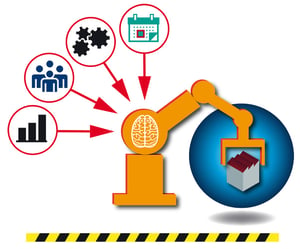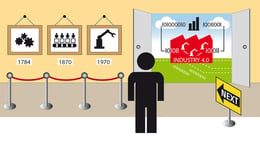Is the Furniture Industry Ready for Industry 4.0?
Brian Hoey - December 18, 2018

 As the era of Industry 4.0 continues to ramp up, new corners throughout the world of industry will continue to see rapid growth and changes—for which they may or may not be prepared! Certainly, the general trend of increasing cyber-physical systems, big data and analytics integration, autonomous machine decision-making, and increased product customization will be apparent to some degree in every Industry 4.0-enabled factory, but the particulars of the Fourth Industry Revolution’s effect will vary widely from industry to industry based on products, product lifecycles, and customer expectations. This means that the picture of Industry 4.0 readiness will look very different in different fields. In furniture manufacturing, for instance, production planners and IT staff may encounter a very different set of challenges than, say, automotive manufacturers.
As the era of Industry 4.0 continues to ramp up, new corners throughout the world of industry will continue to see rapid growth and changes—for which they may or may not be prepared! Certainly, the general trend of increasing cyber-physical systems, big data and analytics integration, autonomous machine decision-making, and increased product customization will be apparent to some degree in every Industry 4.0-enabled factory, but the particulars of the Fourth Industry Revolution’s effect will vary widely from industry to industry based on products, product lifecycles, and customer expectations. This means that the picture of Industry 4.0 readiness will look very different in different fields. In furniture manufacturing, for instance, production planners and IT staff may encounter a very different set of challenges than, say, automotive manufacturers.
Product Customization
As we mentioned above, one of the key components of Industry 4.0 is increased product customization. This can be a major driver of technological change in any industry, but it may be especially impactful in furniture production. Why? Because in recent years there has been an increasing push in the furniture world towards custom-built products, with consumers expecting or even demanding customization more and more frequently. In many industries, Industry 4.0 product customization workflows are often implemented by 3D printing (i.e. additive manufacturing), and while this might be feasible for some furniture products, there will be many more for which customization will be a matter of gaining an extremely granular level of control over various machines and production lines.
Let’s say you’re offering a line of chairs that come in multiple different heights (bar-stool vs. table-height), different colors, and a choice of cushions or no cushions. The path that each product takes through the production plant will be determined by which of these options any given customer selects. In a traditional environment, this level of customization presents challenges in terms of tracking and production planning: How do you make sure each product is taking the most efficient path through the factory? How do you sort orders such that similar products can be batched together correctly? How do you respond to customer orders as they come in? In an Industry 4.0 environment, you could model your various production lines digitally in order to uncover the most efficient way of dividing machine usage up for customization. Likewise, you should be able to receive and analyze customer orders in real time in order to create a dynamic, ever-evolving blueprint for changing production workflows, potentially even automating your factory’s response to real demand as it arises.
Smart Transport Logistics
In the example above, we saw the difference between traditional and Industry 4.0 environments for producing custom products, and we also got a glimpse of the IT requirements that determine a given factory’s readiness for the latter. You need the digital infrastructure to map your physical operations into digital space, you need to develop connectivity between your information technology and your operational technology (in order to create a workflow that gives production processes direct insight into customer orders), and you need to collect high-quality data from across the entire production chain and centralize it in an accessible location. As it happens, these are the same requirements that will be presented in the digitization and optimization of transport logistics. Instead of gaining a high level of insight and control within your production facility, you’ll need to do the same for your transportation network. Why? Because transport logistics within furniture manufacturing present complex problems just waiting to be optimized.
Often, manufacturers will produce their products straight into trucks for deliver rather than warehousing them. While in theory this is the epitome of lean supply chain management, in practice it can be risky. If your products aren’t ready to go at the exactly the right time, your delivery plans could fall apart. If there’s a production overage, it can be difficult to make space for the extra products, since your operations don’t rely on buffer stock. Industry 4.0 systems give you the ability to look at all of your transport options and adjust them on the fly to ensure that you’re always choosing the route that best fits the realities of your customer and production requirements—to say nothing of your budget. Instead of being stuck with static, inflexible transports in an otherwise lean environment, you can leverage real-time data on fuel pricing, demand, and your own production flows in order to create a more flexible transport process that is less susceptible to disruption, more responsive to changing conditions, and more efficient overall.
E2E Visibility (for Customers)
As you’ve read through this post, you may have noticed that customer orders and delivery requirements have come up a few times. That’s no coincidence. As the furniture industry becomes more and more inundated with requests for customized products and consumers across the board come to expect more out of their online orders, businesses will need to ensure that customers are integrating effectively into their operations. The key here is visibility. Not only should your transport planners, for instance, be able to track shipments from the production facility to their final destination, you should be able to make that information accessible to your customers. This requires building out a system that prioritizes end-to-end (E2E) visibility across your entire value chain. This might seem like an onerous requirement, but, luckily, the visibility goes both ways, and should simultaneously make it easier for customer orders and behavior to be registered in production and transport workflows. In this way, you drive towards exactly the kind of connected, interoperable, and flexible system that Industry 4.0 could make increasingly common in the furniture industry.
LATEST POSTS
- Understand Why Production Planning Needs Specialized Solutions
- Understand Circular Economy in The Manufacturing Industry
- How Can Industry 4.0 IT Integration Be Achieved Smoothly?
- The Significance of Order Sequencing in Discrete Manufacturing
- How to improve your Supply Chain Management: The Power of Control Towers



